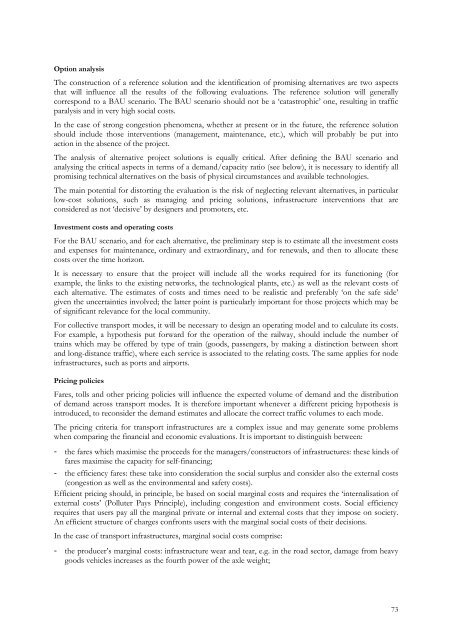Guide to COST-BENEFIT ANALYSIS of investment projects - Ramiri
Guide to COST-BENEFIT ANALYSIS of investment projects - Ramiri
Guide to COST-BENEFIT ANALYSIS of investment projects - Ramiri
Create successful ePaper yourself
Turn your PDF publications into a flip-book with our unique Google optimized e-Paper software.
Option analysisThe construction <strong>of</strong> a reference solution and the identification <strong>of</strong> promising alternatives are two aspectsthat will influence all the results <strong>of</strong> the following evaluations. The reference solution will generallycorrespond <strong>to</strong> a BAU scenario. The BAU scenario should not be a ‘catastrophic’ one, resulting in trafficparalysis and in very high social costs.In the case <strong>of</strong> strong congestion phenomena, whether at present or in the future, the reference solutionshould include those interventions (management, maintenance, etc.), which will probably be put in<strong>to</strong>action in the absence <strong>of</strong> the project.The analysis <strong>of</strong> alternative project solutions is equally critical. After defining the BAU scenario andanalysing the critical aspects in terms <strong>of</strong> a demand/capacity ratio (see below), it is necessary <strong>to</strong> identify allpromising technical alternatives on the basis <strong>of</strong> physical circumstances and available technologies.The main potential for dis<strong>to</strong>rting the evaluation is the risk <strong>of</strong> neglecting relevant alternatives, in particularlow-cost solutions, such as managing and pricing solutions, infrastructure interventions that areconsidered as not ‘decisive’ by designers and promoters, etc.Investment costs and operating costsFor the BAU scenario, and for each alternative, the preliminary step is <strong>to</strong> estimate all the <strong>investment</strong> costsand expenses for maintenance, ordinary and extraordinary, and for renewals, and then <strong>to</strong> allocate thesecosts over the time horizon.It is necessary <strong>to</strong> ensure that the project will include all the works required for its functioning (forexample, the links <strong>to</strong> the existing networks, the technological plants, etc.) as well as the relevant costs <strong>of</strong>each alternative. The estimates <strong>of</strong> costs and times need <strong>to</strong> be realistic and preferably ‘on the safe side’given the uncertainties involved; the latter point is particularly important for those <strong>projects</strong> which may be<strong>of</strong> significant relevance for the local community.For collective transport modes, it will be necessary <strong>to</strong> design an operating model and <strong>to</strong> calculate its costs.For example, a hypothesis put forward for the operation <strong>of</strong> the railway, should include the number <strong>of</strong>trains which may be <strong>of</strong>fered by type <strong>of</strong> train (goods, passengers, by making a distinction between shortand long-distance traffic), where each service is associated <strong>to</strong> the relating costs. The same applies for nodeinfrastructures, such as ports and airports.Pricing policiesFares, <strong>to</strong>lls and other pricing policies will influence the expected volume <strong>of</strong> demand and the distribution<strong>of</strong> demand across transport modes. It is therefore important whenever a different pricing hypothesis isintroduced, <strong>to</strong> reconsider the demand estimates and allocate the correct traffic volumes <strong>to</strong> each mode.The pricing criteria for transport infrastructures are a complex issue and may generate some problemswhen comparing the financial and economic evaluations. It is important <strong>to</strong> distinguish between:- the fares which maximise the proceeds for the managers/construc<strong>to</strong>rs <strong>of</strong> infrastructures: these kinds <strong>of</strong>fares maximise the capacity for self-financing;- the efficiency fares: these take in<strong>to</strong> consideration the social surplus and consider also the external costs(congestion as well as the environmental and safety costs).Efficient pricing should, in principle, be based on social marginal costs and requires the ‘internalisation <strong>of</strong>external costs’ (Polluter Pays Principle), including congestion and environment costs. Social efficiencyrequires that users pay all the marginal private or internal and external costs that they impose on society.An efficient structure <strong>of</strong> charges confronts users with the marginal social costs <strong>of</strong> their decisions.In the case <strong>of</strong> transport infrastructures, marginal social costs comprise:- the producer’s marginal costs: infrastructure wear and tear, e.g. in the road sec<strong>to</strong>r, damage from heavygoods vehicles increases as the fourth power <strong>of</strong> the axle weight;73




